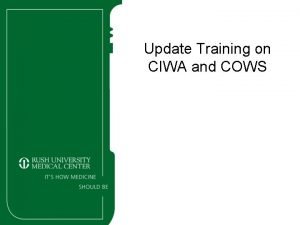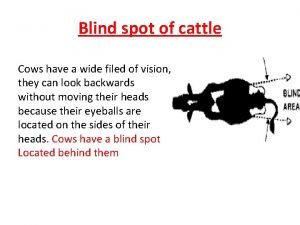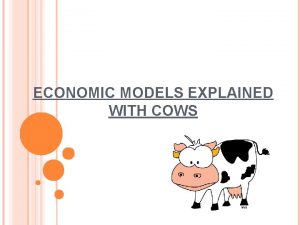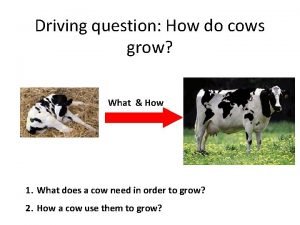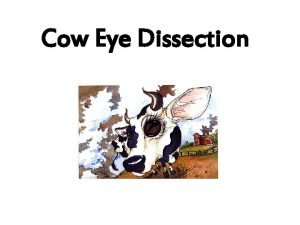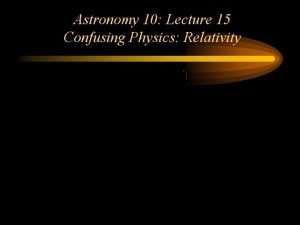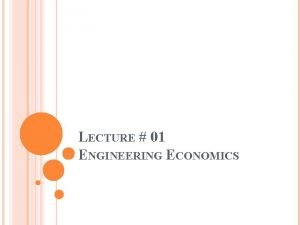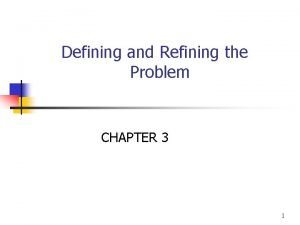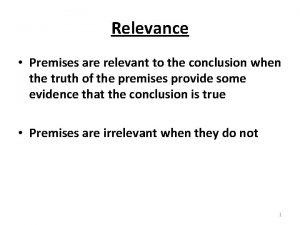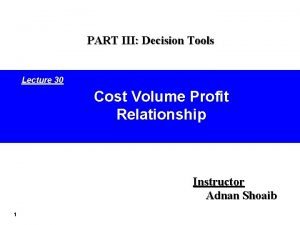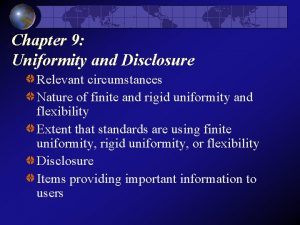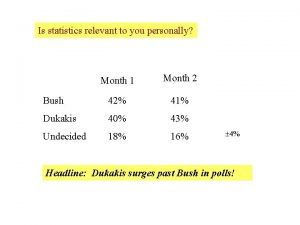Are statistics relevant to you personally Example Cows





















































- Slides: 53

Are statistics relevant to you personally? • Example: Cows Milk • Benefits – – Strong Bones Strong Muscles Calcium Uptake Vitamin D • Have you ever seen any statistics on cow’s milk? • What evidence do you have?

Statistics taken from “The China Study” by Professor of Nutrition T. Colin Campbell at Cornell University and his son Thomas M. Campbell Read China Study

More Statistics on Cow’s Milk Read China Study

More Statistics on Cow’s Milk Read China study

What kinds of things can you measure quantitatively? What kinds of things can you measure qualitatively? What is the difference between a qualitative and quantitative measurement? Which of these types of measurement are important in science? In so far as possible, physics is exact and quantitative … though you will repeatedly see mathematical approximations made to get at the qualitative essence of phenomena.

Accuracy: A measure of closeness to the “truth”. Precision: A measure of reproducibility.

Accuracy vs. precision accurate precise

Types of errors Statistical error: Results from a random fluctuation in the process of measurement. Often quantifiable in terms of “number of measurements or trials”. Tends to make measurements less precise. Systematic error: Results from a bias in the observation due to observing conditions or apparatus or technique or analysis. Tend to make measurements less accurate.

Example of Statistical Error Read China Study Strong Correlation? Yes, well… maybe, but

Example Continued Read China Study No Correlation!

# Measured Mean True Mean time

Parent distribution (infinite number of measurements) # time True value

The game: From N (not infinite) observations, determine “ ” and the “error on ” … without knowledge of the “truth”. # Measured Mean True mean time

The parent distribution can take different shapes, depending on the nature of the measurement. The two most common distributions one sees are the Gaussian and Poisson distributions.

Most probable value Highest on the curve. Most likely to show up in an experiment. Probability or number of counts x

Most probable value Median Value of x where 50% of measurements fall below and 50% of measurements fall above Probability or number of counts x

Most probable value Median Mean or average value of x Probability or number of counts x

The most common distribution one sees (and that which is best for guiding intuition) is the Gaussian distribution. counts x

For this distribution, the most probable value, the median value and the average are all the same due to symmetry. counts x

The most probable estimate of is given by the mean of the distribution of the N observations counts True value measured mean value

counts True value measured mean value

Error goes like True value But this particular quantity “averages” out to zero. Try f( -xi)2 instead. measured mean value,

The “standard deviation” is a measure of the error in each of the N measurements. x

is unknown. So use the mean (which is your best estimate of ). Change denominator to increase error slightly due to having used the mean. This is the form of the standard deviation you use in practice. This quantity cannot be determined from a single measurement.

Gaussian distribution counts x

Gaussian distribution intuition 1 is the width at Of the peak height counts x

Gaussian distribution intuition Probability of a measurement falling within 1 of the mean is 0. 683 counts x

Gaussian distribution intuition Probability of a measurement falling within 2 of the mean is 0. 954 counts x

Gaussian distribution intuition Probability of a measurement falling within 3 of the mean is 0. 997 counts x

The standard deviation is a measure of the error made in each individual measurement. Often you want to measure the mean and the error in the mean. Which should have a smaller error, an individual measurement or the mean? Error in the mean

Student 1: 9. 0 m/s 2 Student 2: 8. 8 m/s 2 Student 3: 9. 1 m/s 2 Student 4: 8. 9 m/s 2 Student 5: 9. 1 m/s 2

Student 1: 9. 0 m/s 2 Student 2: 8. 8 m/s 2 Student 3: 9. 1 m/s 2 Student 4: 8. 9 m/s 2 Student 5: 9. 1 m/s 2

Student 1: 9. 0 m/s 2 Student 2: 8. 8 m/s 2 Student 3: 9. 1 m/s 2 Student 4: 8. 9 m/s 2 Student 5: 9. 1 m/s 2

How does an error in one measurable affect the error in another measurable? y y=F(x) y+ y y 1 y- y X- x x 1 x+ x x

The degree to which an error in one measurable affects the error in another is driven by the functional dependence of the variables (or the slope: dy/dx) y y=F(x) y+ y y 1 y- y X- x x 1 x+ x x

The complication Most physical relationships involve multiple measurables! y = F(x 1, x 2, x 3, …) Must take into account the dependence of the final measurable on each of the contributing quantities.

Partial derivatives What’s the slope of this graph? ? For multivariable functions, one needs to define a “derivative” at each point for each variable that projects out the local slope of the graph in the direction of that variable … this is the “partial derivative”.

Partial derivatives The partial derivative with respect to a certain variable is the ordinary derivative of the function with respect to that variable where all the other variables are treated as constants.

Example

The formula for error propagation If f=F(x, y, z…) and you want f and you have x, y, z …, then use the following formula:

The formula for error propagation If f=F(x, y, z…) and you want f and you have x, y, z …, then use the following formula: Measure of error in x

The formula for error propagation If f=F(x, y, z…) and you want f and you have x, y, z …, then use the following formula: Measure of dependence of F on x

The formula for error propagation If f=F(x, y, z…) and you want f and you have x, y, z …, then use the following formula: Similar terms for each variable, add in quadrature.

Example A pitcher throws a baseball a distance of 30± 0. 5 m at 40± 3 m/s (~90 mph). From this data, calculate the time of flight of the baseball.


Why are linear relationships so important in analytical scientific work? y y=F(x) y 1 x

y y=F(x)=mx+b Is this a good “fit”? x

y y=F(x)=mx+b Is this a good fit? Why? x

y y=F(x)=mx+b Is this a good fit? x

Graphical analysis y pencil and paper still work! y=F(x)=mx+b Slope (m) is rise/run x b is the y-intercept

Graphical determination of error in slope and y-intercept y y=F(x)=mx+b x

Linear regression y With computers: y=F(x)=mx+b Garbage in Garbage out x

Linear regression Hypothesize a line y=F(x)=mx+b
 Antigentest åre
Antigentest åre Knowing god personally
Knowing god personally How to know god personally four spiritual principles
How to know god personally four spiritual principles Personally identifiable information pii training 1 hour
Personally identifiable information pii training 1 hour Affective play space
Affective play space You have 2 cows
You have 2 cows Abdecario
Abdecario You have two cows
You have two cows Litreature review
Litreature review Introduction to statistics what is statistics
Introduction to statistics what is statistics Peripheral vs central vertigo
Peripheral vs central vertigo Cows vs ciwa
Cows vs ciwa Mydiatrics
Mydiatrics Hawk d'onofrio
Hawk d'onofrio A cow give us
A cow give us Anatomy of female cow reproductive system
Anatomy of female cow reproductive system Every good boy does fine all cows eat grass
Every good boy does fine all cows eat grass Codominance in cows
Codominance in cows Click, clack, moo cows that type comprehension questions
Click, clack, moo cows that type comprehension questions Parts of a cows stomach
Parts of a cows stomach Anti cow kicker
Anti cow kicker Cows economic models
Cows economic models Jamaica hope cattle
Jamaica hope cattle First aid sequence
First aid sequence How do cows grow
How do cows grow Eye dissection worksheet
Eye dissection worksheet Cadbury silk
Cadbury silk Cows near an electric fence einstein
Cows near an electric fence einstein Political ideologies cows
Political ideologies cows Cows
Cows Hydrometra uterus
Hydrometra uterus Hormones in cows
Hormones in cows Diastema in cows
Diastema in cows Narayana's cows sequence
Narayana's cows sequence Irrelevant sentence examples
Irrelevant sentence examples Decision making and relevant information
Decision making and relevant information Relevant cost adalah
Relevant cost adalah Steps in decision making
Steps in decision making Consider all relevant criteria
Consider all relevant criteria Broad problem area
Broad problem area Culturally responsive vs culturally relevant
Culturally responsive vs culturally relevant Select significant and relevant information
Select significant and relevant information Contoh anggaran variabel
Contoh anggaran variabel Relevant premises
Relevant premises Within the relevant range, variable costs are expected to
Within the relevant range, variable costs are expected to Relevant cost for decision making exercises
Relevant cost for decision making exercises Relevant cost for decision making solution chapter 13
Relevant cost for decision making solution chapter 13 Chapter 11 decision making and relevant information
Chapter 11 decision making and relevant information What is font
What is font Is the bible relevant today
Is the bible relevant today Relevant circumstances adalah
Relevant circumstances adalah Chapter 11 decision making and relevant information
Chapter 11 decision making and relevant information Prefetching relevant priors
Prefetching relevant priors Relevant contextual factors
Relevant contextual factors











